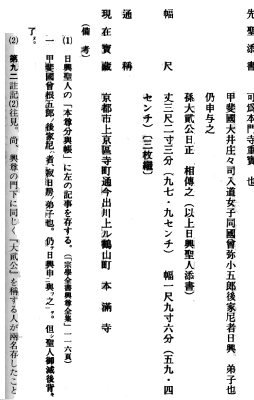
Nichiren Shonin
Gohonzon Shu

O'Mandalas by St. Nichiren
[1222-1282]

 |
Nichiren Shonin |  |
|
Sakyamuni appeared in the Western realm [India] and, in accordance with the original intent of all Buddhas, preached the Sutra of the Wonderful Dharma of the Lotus Blossom and declared, "Now this threefold world is all my domain." In our country, he appeared as Tensho Daijin [the Sun Goddess], and, through the ruler, protects honest people. This means that Sakyamuni and the Sun Goddess are one entity. In the Final Dharma age, he appeared as Nichiren, who made manifest the essential Dharma [of the daimoku], which is the true intent of the Buddhas. Thus Sakyamuni, [Bodhisattva] Superior Conduct, the sun kami, and Nichiren are simply one entity. One should reflect on these [names]: Sun Seed [an epithet of Sakyamuni], Sun Diety (nisshin), and Sun Lotus [Nichiren].Equations of specific Buddhist and Shinto deities often involve claims about the legitimacy and authority of particular institutions. Here the authority of the Sun Goddess and the throne are assimilated to the Hokkeshu via the person of Nichiren, carrying an implicit challenge to the authority of other religious traditions, such as Sanno Shinto of Mt. Hiei, which also identifies Sakyamuni with the Sun Goddess enshrined at Ise, or the esoteric traditions of both Tendai and Shingon that equated Dainichi with the Sun Goddess. The identification of Nichiren with the Sun Goddess is especially pronounced in transmissions of the Fuji school, which exalt the status of Nichiren to that of the original Buddha. Consider, for example, this passage from the Ubuya sojo no koto, a Fuji transmission that deals not with the mandala specifically, but with Nichiren's parentage and the significance of his name. It presents itself as Byakuren Ajari Nikko's transcription of Nichiren's words:
"Nichiren" is the natural name of Mt. Fuji. Fuji is [simply] the name of the district. [The mountain's] real name is Dainichi-renge-zan [Great Sun Lotus Blossom Mountain]. Because of my practice of the Middle Way, the country is thus called Nihon [Sun Origin], and its kami is the Sun Diety. The Buddha's childhood name was Crown Prince Sun Seed, and my childhood name was Zennichi [Good Sun]. My temporary [monastic] name was Zesho [written "person born under the sun"], and my true name is Nichiren.Here again, Sakyamuni, the Sun Goddess, and Nichiren are identified by the shared element of "sun" in their respective names. By one of the temporal reversals common in kanjin-style interpretations, the word "sun" in the name of both the country and its major deity are made to derive from the name of Nichiren. Mt. Fuji, location of the first temple in Nikko's lineage, is also drawn into the equation. Medieval documents of the Fuji school employ such interpretations in arguing that the kaidan of the origin teaching should eventually be erected at Mt. Fuji.
Ongi Kuden Nikko
|
The explanation below refers to Mandala #92. |
 |
 |
![]()
![]()
Gohonzonsh¯u (129 halographs)
|

|
|
Worldwide Directory | Site Map | Advertising | Buddhas | Discuss | Gohonzon | Gosho | Fuju_Fuse | Honmon_Butsuryu | Independents | Kishimojin | Lotus_Sutra | Mikkyo | Miraculous_Tales | Nichiren | Nipponzan | Nichiren_Shoshu | Nichiren_Shu | Pilgrimage | Prayer | Pure_Land | Queers | Reiyukai | Rissho_Koseikai | Soka_Gakkai | Stupas | Sutra_Library | Tendai | Theravada | WebRings | Women | Misc. | BuddhistInmates.net | Dharma-House.org | Ryuei.net | Sivartha's_Mind_Maps |
![]()
![]()
| ||||
| ||||
| ||||